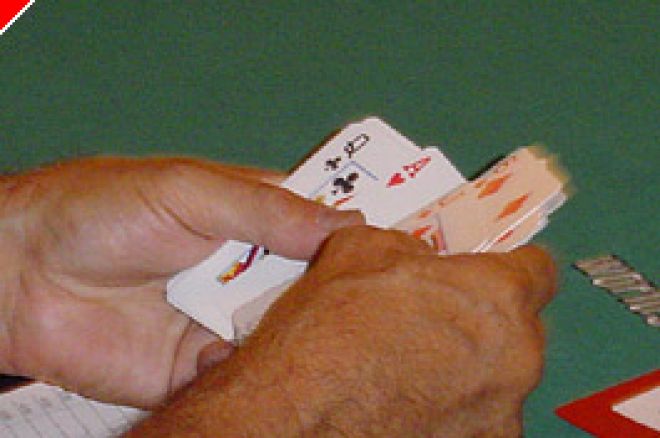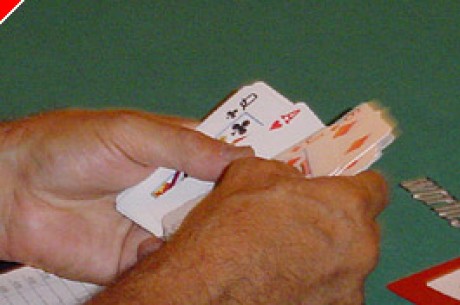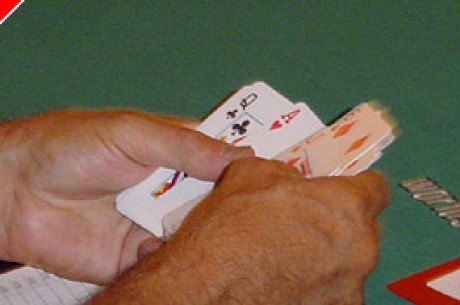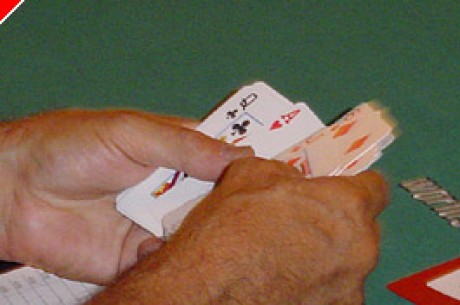Stud Poker Strategy - Are you Doggin' It?, Part II

In my last column we looked at the likelihood that someone would win when he started out with a hand on third street that was an underdog. We looked just at the match up statistically – not accounting for whether the raiser might have been bluffing when he represented a higher hand with a raise. I promised to look at all parts of this decision, as a possible underdog, when you decide whether or not to call.
Let's say, for example, that you have a pair of 2s with and unexposed Ace kicker. (2♣ A♦) 2♥ for example. To your immediate right is XxK♣. He completes the bet to $10.00. He isn't a wild player, but then again he's been known to try an ante steal now and again.
He's the high hand showing. There are a couple of players with paint and there are no other 2s, Aces or Kings showing.
For the sake of this example, let's say you brought it in for $3.00 with your 2♥ and everyone folded up to the King. He completed the bet to $10. Does it make sense for you to call? Let's assume for the moment that raising is not an option. Just decide whether it makes sense to call or not.
First of all, as we saw in the last column, you are an underdog – but not a huge one – to a pair of Kings – the hand your opponent is representing. If you were playing with your cards exposed and you knew that he had the pair of Kings he was representing then it would make surely make sense to fold. You are a 42:58 underdog. You will lose this match up 58% of the time. So for every $10 you put in – for each small bet – you are only getting a return of $8.40. Assuming you call every bet until the River. You will invest two small bets and three big bets for $80 and only get a 42% return on the eventual bets of $67.20 plus 42% of the antes and bring-in – another $4.62. $80 from you and only an additional $71.80. You'll lose almost $9 for every hand played this way.
But wait. This is what would happen if the hand were played to conclusion with the cards fully known to you – and with no chance that your opponent had something other than what he represented. This player, however, does not always have what he's representing. Sometimes he steals antes – with bluffs. This means that sometimes he has something other than a pair of Kings – something that your pair of 2s with an Ace kicker is not an underdog to.
Let's say that half the time he raises with the King he actually has the pair and half the time he doesn't – he has absolutely nothing – just a King high. (Of course this supposition will always be true – since some of the time when he raises he'll have a pocket pair and a King – but for the sake of this simple explanation assume that this is never the case). Half of the time you have the advantage with a pair of 2s and an Ace and he has a King high and half of the time he has the advantage with a pair of Kings.
Assume also that he plays the hand in exactly the same way no matter what he has. He plays it to the end in the same way whether he's bluffing or whether he's value betting. And, further, for the sake of this example, assume that you will not be able to detect any difference in what he has as the hand progresses, no matter what cards he gets or what cards you get. In reality, all of these things that I'm ruling out may come into play. But for this example assume that they all balance out and you will each play your hands exactly the same no matter what starting hand he has.
Now in this admittedly forced example you will be behind him half of the time — to the tune of being a 42% to 58% underdog. But 50% of the time you'll be in the lead. According to the wonderful convenient site twodimes.net, we can quickly see how much of an advantage your deuces with an Ace kicker has over his bluff of two random cards with a King. In those instances you're a 62% to 38% favorite. You'll win those match ups 62% of the time. This means that for every $10 you invest in the hand you're going to get a return of $12.40. For a complete hand you'll be getting, for your $80 invested with all bets made and called until the River, a return of $99.20 plus the 62% of the $11 in the pot from antes and forced bets – or roughly $106. That's a net profit of $26.00 per hand.
If you remember our first example, where you were certain that your opponent had the pair of Kings, you lost $9.00 a hand played to completion. In this instance you won $26.00 when playing the hand to completion. Overall then, if your opponent bluffs 50% of the time when he has an exposed King and you call him down 100% of the time with you pair of deuces with an Ace kicker you'll end up profiting $17.00 a hand.
Before you conclude that you should always call along with an underpair and a overkicker, consider that the example I gave you was especially contrived and admittedly unusual. First of all, how would you know that someone was bluffing 50% of the time? That's a very high frequency for an ante steal. All but the wildest players probably bluff less than a third of the time. I'm so tight I don't think I'd be bluffing with a King more than 15 or 10% of the time. And, even if someone begins with an ante steal, how often do they attempt to carry it through to conclusion by betting every street until the river? Most players, the vast majority in fact, tend to stop their steal attempt on third or fourth street. In other words, if you call their raise on third street, they'll check on fourth.
Similarly, how many times does it really come down to just you and the ante stealer on third? Often there are other players still in the hand mucking up the easy math that I presented. There may also be exposed or folded cards that need to be taken into consideration when deciding both on the likelihood that your opponent really has what he represents and his and your chances of improving on subsequent hands. If, for example, either your Aces or 2s are partially dead on third street, your chances of overtaking your opponent's pair of Kings are greatly reduced.
For now, however, just know that the chances of your hand winning on the river increase as your estimate of your opponent's likelihood of being on a bluff increases. You can actually do the math as I have done to help you decide whether it makes sense to call or fold to his raise on third street. Of course, it's tough to do the full equation in your head every time it comes up. So it's probably more useful to come up with some general rules of thumb to help guide your play in these instances. I'll get to that in another column. But first, in my next column, I'd like to address another factor that should go into this decision – namely the action of other players in the hand.
Ed Note: Saddle up, and play some Stud at Poker Stars - just don't start Doggin' it.








